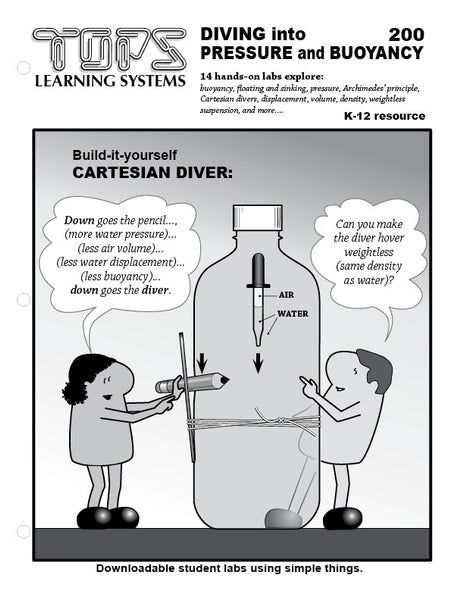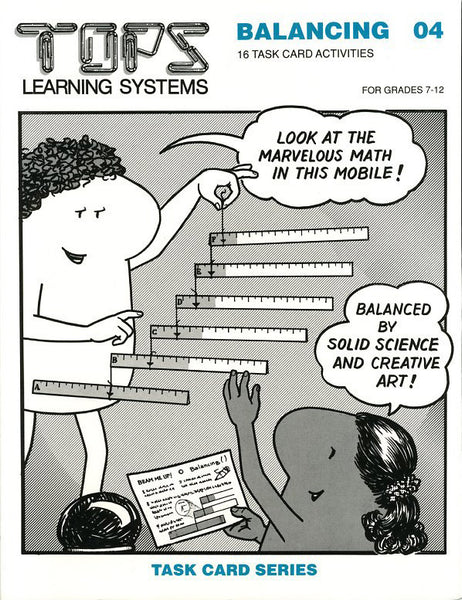#200 Diving Into Pressure and Buoyancy (grade K-12)
Regular price $11.25
Cartesian divers immerse students into deep understandings of floating and sinking, buoyancy, pressure, Archimedes’ principle, displacement, volume, density, weightless suspension, and more. Differentiated instruction accommodates widely divergent student ability levels and flexibly adapts to tight time schedules. You recycle your own soda bottles. We provide glass eyedroppers of appropriate size if you don’t already have your own.
Click here for a complete list of materials and convenient shopping.
2-liter plastic soda bottles with tight-fitting lids, water source, glass eyedroppers, waxed dental floss, scissors, straws, paper punch tools, string, craft sticks, rubber bands, clear tape, test tubes, deep glasses or tall jars, trays to catch water overflow, condiment packets (fast-food type), pinches modeling clay, staples, paper clips- Lab A: To improvise a "catcher" with which to rescue an eyedropper "diver" from a bottle of water. To practice rescue skills.
- Lab B: To complete construction of the diver catcher. To practice "grabbing" a low-floating diver from the mouth of a bottle of water.
- Lab C: To adjust the volume of air in an eyedropper so it has positive buoyancy at the top of a bottle of water, and negative buoyancy at the bottom.
- To propose an hypothesis to account for this phenomenon.
- Lab D: To observe the floating and sinking properties of a Cartesian Diver. To experience the relationship between air volume and pressure.
- Lab E: To understand buoyancy in terms of Archimedes' Principle. To understand rocket thrust in terms of Newton's Third Law of action and reaction.
- Lab F: To develop a kinesthetic feel for how water pressure increases with depth. To understand that a diver hovers in weightless buoyancy when its average density equals the density of water.
- Lab G: To use subtle pressure changes to control a diver that has neutral buoyancy. To discover that a diver's hover point is inherently unstable.
- Lab H: To finely adjust air volumes in a Cartesian diver. To win a "slowest-rising-diver" competition.
- Lab I: To discover, develop and refine ways to apply hand pressure to an open bottle of water to make a diver sink, float, and hover.
- Lab J: To correlate relative up and down changes in a diver's hover point with changes in pressure.
- Lab K: To correlate relative up and down changes in a diver's hover point with changes in temperature.
- Lab L: To turn a test tube into a Cartesian diver. To understand why it floats and sinks.
- Lab M: To invent a Cartesian diver out of unusual materials. To have fun.
- Lab N: To do science: wonder, predict, experiment, observe, conclude, then ask more questions.
(K-4): Observe changes in a Cartesian diver when you squeeze this bottle. The harder you squeeze, the faster it sinks. Can you turn a packet of salsa into a Cartesian diver?
(5-8): Squeeze a bottle of water with a floating Cartesian diver sealed inside. This mechanical pressure transfers force throughout the water in all directions. Yet only compressible air inside the diver reduces to a smaller volume. Would a test object still dive if it didn't contain a compressible gas?
(9-12): Squeezing a Cartesian diver compresses its widely-spaced gas molecules much more than its closely-spaced liquid molecules. This decrease in the diver's air volume reduces the amount of water it displaces, increases its density, and decreases its buoyancy. How might you use this diver to monitor changing room temperature?
NOTE: We encourage improvisation - it's one of the main goals of our hands-on approach! You and your students might invent a simpler, sturdier or more accurate system; might ask a better question; might design a better extension. Hooray for ingenuity! When this occurs, we'd love to hear about it and share it with other educators.
TEACHING Standards
These 14 TOPS Labs promote excellence in science teaching by these NSES criteria:
Teachers of science...
A: ...plan an inquiry-based science program. (p. 30)
B: ...guide and facilitate learning. (p. 32)
C: ...engage in ongoing assessment of their teaching and of student learning. (p. 37)
D: ...design and manage learning environments that provide students with the time, space, and resources needed for learning science. (p. 43)
CONTENT Standards
These 14 TOPS contain fundamental content as defined by these NSES guidelines (p. 109):
• Represent a central event or phenomenon in the natural world.
• Represent a central scientific idea and organizing principle.
• Have rich explanatory power.
• Guide fruitful investigations.
• Apply to situations and contexts common to everyday experiences.
• Can be linked to meaningful learning experiences.
• Are developmentally appropriate for students at the grade level specified.
Unifying Concepts and Processes
closed systems • open systems • regularities • theories • models • prediction • evidence • observation • explanation • interaction • change • measurement
Science as Inquiry (content standard A)
question • plan • design • investigate • gather data • classify • use technological tools • quantify • analyze • interpret • predict • communicate • reason • logic • evidence • variables • cause and effect
Physical Science (content standard B)
NSES Framework: properties of matter • changing properties • motions • forces Core Inquiries: buoyancy • floating and sinking • pressure • Archimedes' principle • Cartesian divers • fluids • displacement • pressure changes with depth • compressibility • density • volume • temperature • weight • weightless suspension • unstable equilibrium • ideal gas relationships (PV = kT)
Related Explorations: air • water • Boyle's Law • Charles' Law • Newton's 3rd law (action/reaction) • cohesion/adhesion • surface tension
Science and Technology (content standard E)
invention • design • tools






